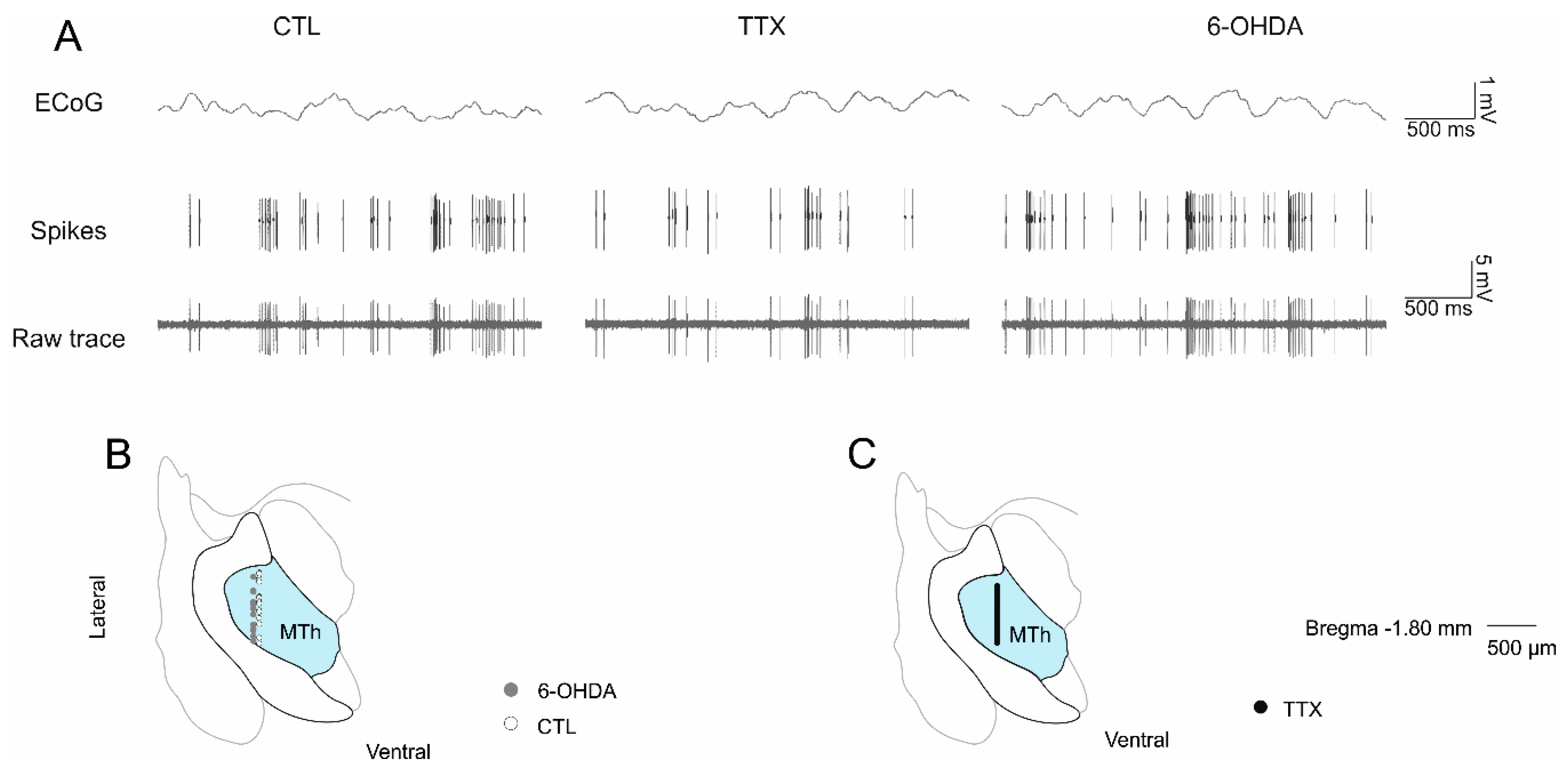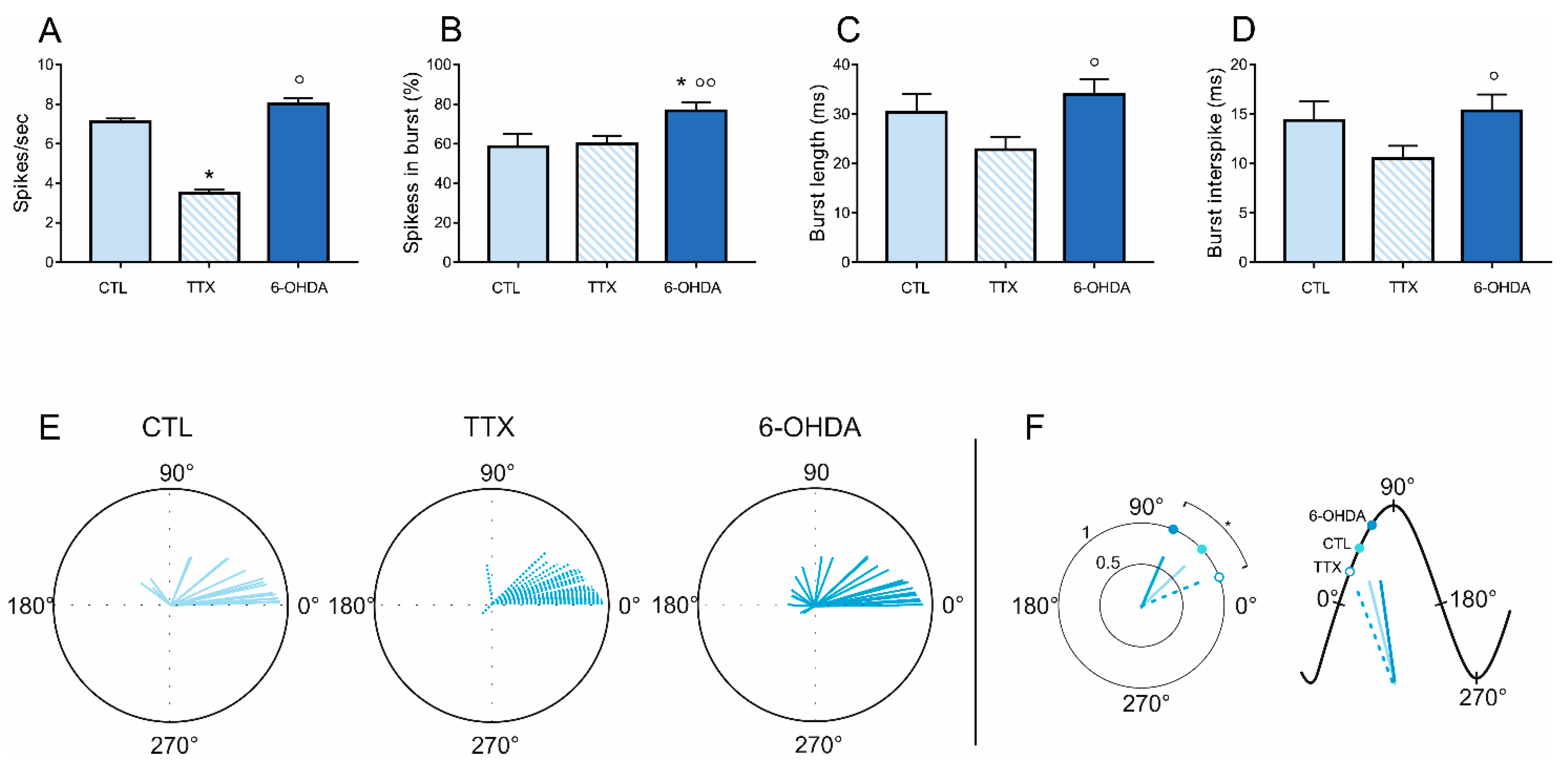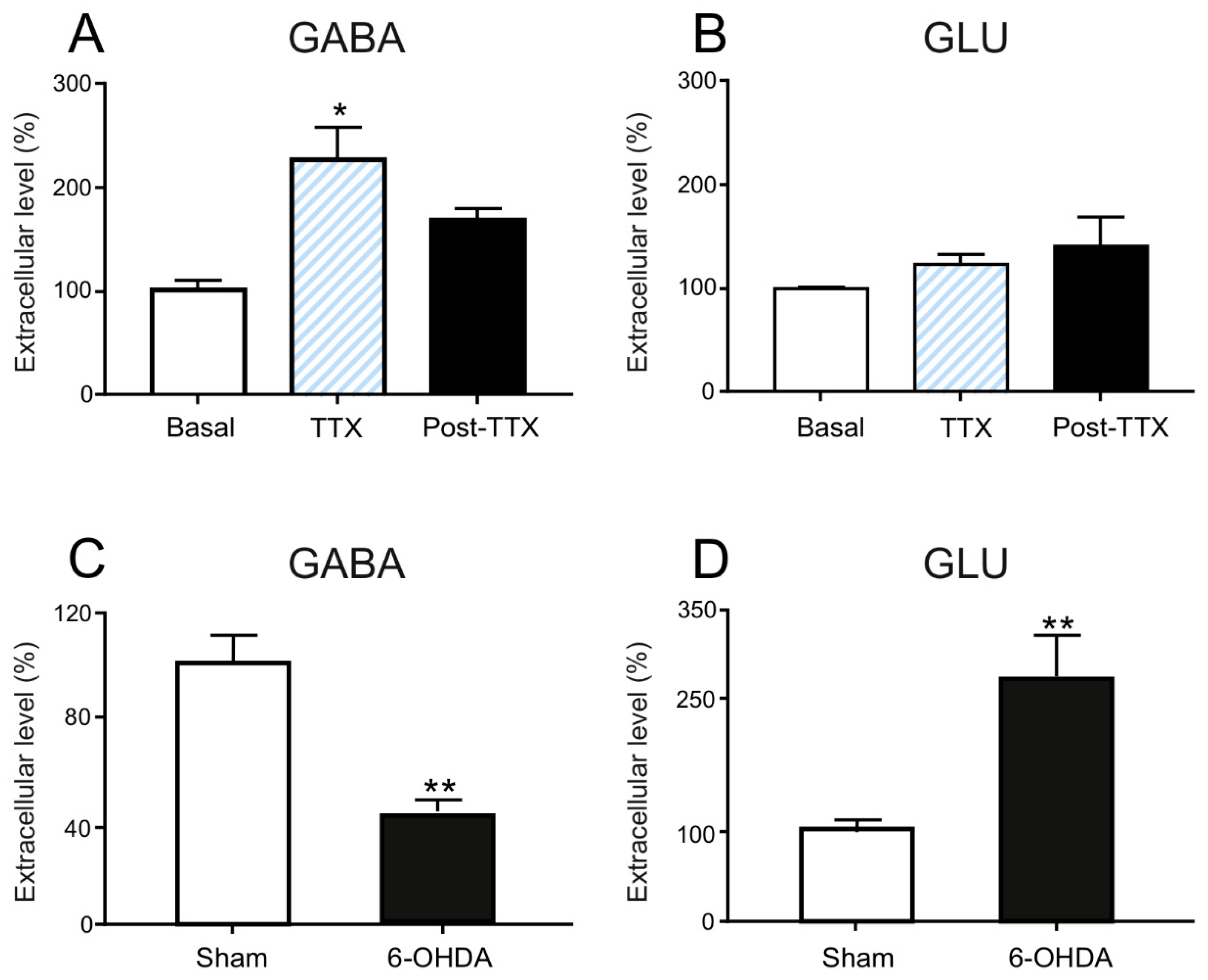Acute and Chronic Dopaminergic Depletion Differently Affect Motor Thalamic Function
Abstract
1. Introduction
2. Results
2.1. Effects of DA Depletion on the Activity of the Motor Thalamus Neurons
2.2. Effects of DA Depletion on the Cortical–Thalamic Coupling
2.3. Effects of DA Depletion on the Extracellular Levels of GABA and GLU in the Motor Thalamus
3. Discussion
4. Materials and Methods
4.1. Animals
4.2. Pharmacological Blockade of the Medial Forebrain Bundle
4.3. Unilateral 6-OHDA Lesion
4.4. Prerecording Surgery
4.5. Electrophysiological Recordings
4.6. Microdialysis Analysis
4.7. Histological and Microscopic Analysis
4.8. Statistical Analysis
Author Contributions
Funding
Conflicts of Interest
Abbreviations
| MTh | motor thalamus |
| DA | dopamine |
| GLU | glutamate |
| GABA | gamma-aminobutyric acid |
| TTX | tetrodotoxin |
| 6-OHDA | 6-hydroxydopamine |
| VA | ventral-anterior thalamus |
| VM | ventral-medial |
| SNr | substantia nigra pars reticulata |
| GPi | internal globus pallidus |
| NRT | nucleus reticular thalami |
| SN | substantia nigra |
| substantia | substantia nigra pars compacta |
| PD | Parkinson’s disease |
| STN | sub-thalamic nucleus |
| DBS | deep brain stimulation |
| L-DOPA | levodopa |
| HT2A | entopeduncular nucleus |
| EPN | immunohistochemistry |
| LID | L-DOPA-induced dyskinesia |
| SWA | slow-wave activity |
| MFB | medial forebrain bundle |
References
- Bosch-Bouju, C.; Hyland, B.I.; Parr-Brownlie, L.C. Motor thalamus integration of cortical, cerebellar and basal ganglia information: Implications for normal and parkinsonian conditions. Front. Comput. Neurosci. 2013, 7, 163. [Google Scholar] [CrossRef]
- Nakamura, K.C.; Sharott, A.; Magill, P.J. Temporal coupling with cortex distinguishes spontaneous neuronal activities in identified basal ganglia-recipient and cerebellar-recipient zones of the motor thalamus. Cereb. Cortex 2014, 24, 81–97. [Google Scholar] [CrossRef] [PubMed]
- Wichmann, T.; Kliem, M.A. Neuronal activity in the primate substantia nigra pars reticulata during the performance of simple and memory-guided elbow movements. J. Neurophysiol. 2004, 91, 815–827. [Google Scholar] [CrossRef][Green Version]
- Avila, I.; Parr-Brownlie, L.C.; Brazhnik, E.; Castaneda, E.; Bergstrom, D.A.; Walters, J.R. Beta frequency synchronization in basal ganglia output during rest and walk in a hemiparkinsonian rat. Exp. Neurol. 2010, 221, 307–319. [Google Scholar] [CrossRef] [PubMed]
- Pare, D.; Steriade, M.; Deschenes, M.; Oakson, G. Physiological characteristics of anterior thalamic nuclei, a group devoid of inputs from reticular thalamic nucleus. J. Neurophysiol. 1987, 57, 1669–1685. [Google Scholar] [CrossRef] [PubMed]
- Grandi, L.C.; Kaelin-Lang, A.; Orban, G.; Song, W.; Salvade, A.; Stefani, A.; Di Giovanni, G.; Galati, S. Oscillatory Activity in the Cortex, Motor Thalamus and Nucleus Reticularis Thalami in Acute TTX and Chronic 6-OHDA Dopamine-Depleted Animals. Front. Neurol. 2018, 9, 663. [Google Scholar] [CrossRef]
- Yamamoto, T.; Noda, T.; Miyata, M.; Nishimura, Y. Electrophysiological and morphological studies on thalamic neurons receiving entopedunculo- and cerebello-thalamic projections in the cat. Brain Res. 1984, 301, 231–242. [Google Scholar] [CrossRef]
- Kakei, S.; Na, J.; Shinoda, Y. Thalamic terminal morphology and distribution of single corticothalamic axons originating from layers 5 and 6 of the cat motor cortex. J. Comp. Neurol. 2001, 437, 170–185. [Google Scholar] [CrossRef]
- Kultas-Ilinsky, K.; Sivan-Loukianova, E.; Ilinsky, I.A. Reevaluation of the primary motor cortex connections with the thalamus in primates. J. Comp. Neurol. 2003, 457, 133–158. [Google Scholar] [CrossRef]
- Antal, M.; Beneduce, B.M.; Regehr, W.G. The substantia nigra conveys target-dependent excitatory and inhibitory outputs from the basal ganglia to the thalamus. J. Neurosci. 2014, 34, 8032–8042. [Google Scholar] [CrossRef]
- Yague, J.G.; Cavaccini, A.; Errington, A.C.; Crunelli, V.; Di Giovanni, G. Dopaminergic modulation of tonic but not phasic GABAA-receptor-mediated current in the ventrobasal thalamus of Wistar and GAERS rats. Exp. Neurol. 2013, 247, 1–7. [Google Scholar] [CrossRef] [PubMed]
- Lavin, A.; Grace, A.A. Dopamine modulates the responsivity of mediodorsal thalamic cells recorded in vitro. J. Neurosci. 1998, 18, 10566–10578. [Google Scholar] [CrossRef] [PubMed]
- Carlsson, M.; Carlsson, A. Interactions between glutamatergic and monoaminergic systems within the basal ganglia--implications for schizophrenia and Parkinson’s disease. Trends Neurosci. 1990, 13, 272–276. [Google Scholar] [CrossRef]
- Munoz, M.D.; de la Fuente, N.; Sanchez-Capelo, A. TGF-beta/Smad3 Signalling Modulates GABA Neurotransmission: Implications in Parkinson’s Disease. Int. J. Mol. Sci. 2020, 21, 590. [Google Scholar] [CrossRef] [PubMed]
- Esposito, E.; Di Matteo, V.; Di Giovanni, G. Death in the substantia nigra: A motor tragedy. Expert Rev. Neurother. 2007, 7, 677–697. [Google Scholar] [CrossRef]
- Hammond, C.; Bergman, H.; Brown, P. Pathological synchronization in Parkinson’s disease: Networks, models and treatments. Trends Neurosci. 2007, 30, 357–364. [Google Scholar] [CrossRef]
- Boraud, T.; Bezard, E.; Bioulac, B.; Gross, C.E. From single extracellular unit recording in experimental and human Parkinsonism to the development of a functional concept of the role played by the basal ganglia in motor control. Prog. Neurobiol. 2002, 66, 265–283. [Google Scholar] [CrossRef]
- Albin, R.L.; Young, A.B.; Penney, J.B. The functional anatomy of basal ganglia disorders. Trends Neurosci. 1989, 12, 366–375. [Google Scholar] [CrossRef]
- DeLong, M.R. Primate models of movement disorders of basal ganglia origin. Trends Neurosci. 1990, 13, 281–285. [Google Scholar] [CrossRef]
- Stefani, A.; Fedele, E.; Vitek, J.; Pierantozzi, M.; Galati, S.; Marzetti, F.; Peppe, A.; Bassi, M.S.; Bernardi, G.; Stanzione, P. The clinical efficacy of L-DOPA and STN-DBS share a common marker: Reduced GABA content in the motor thalamus. Cell Death Dis. 2011, 2, e154–e154. [Google Scholar] [CrossRef]
- Stefani, A.; Fedele, E.; Pierantozzi, M.; Galati, S.; Marzetti, F.; Peppe, A.; Pastore, F.S.; Bernardi, G.; Stanzione, P. Reduced GABA Content in the Motor Thalamus during Effective Deep Brain Stimulation of the Subthalamic Nucleus. Front. Syst. Neurosci. 2011, 5, 17. [Google Scholar] [CrossRef] [PubMed]
- Korkmaz, O.T.; Tuncel, N.; Tuncel, M.; Oncu, E.M.; Sahinturk, V.; Celik, M. Vasoactive intestinal peptide (VIP) treatment of Parkinsonian rats increases thalamic gamma-aminobutyric acid (GABA) levels and alters the release of nerve growth factor (NGF) by mast cells. J. Mol. Neurosci. 2010, 41, 278–287. [Google Scholar] [CrossRef] [PubMed]
- Gerlach, M.; Gsell, W.; Kornhuber, J.; Jellinger, K.; Krieger, V.; Pantucek, F.; Vock, R.; Riederer, P. A post mortem study on neurochemical markers of dopaminergic, GABA-ergic and glutamatergic neurons in basal ganglia-thalamocortical circuits in Parkinson syndrome. Brain Res. 1996, 741, 142–152. [Google Scholar] [CrossRef]
- Robelet, S.; Melon, C.; Guillet, B.; Salin, P.; Kerkerian-Le Goff, L. Chronic L-DOPA treatment increases extracellular glutamate levels and GLT1 expression in the basal ganglia in a rat model of Parkinson’s disease. Eur. J. Neurosci. 2004, 20, 1255–1266. [Google Scholar] [CrossRef]
- Biggs, C.S.; Starr, M.S. Dopamine and glutamate control each other’s release in the basal ganglia: A microdialysis study of the entopeduncular nucleus and substantia nigra. Neurosci. Biobehav. Rev. 1997, 21, 497–504. [Google Scholar] [CrossRef]
- Marsden, C.D.; Obeso, J.A. The functions of the basal ganglia and the paradox of stereotaxic surgery in Parkinson’s disease. Brain A J. Neurol. 1994, 117, 877–897. [Google Scholar] [CrossRef]
- Grandi, L.C.; Di Giovanni, G.; Galati, S. Animal models of early-stage Parkinson’s disease and acute dopamine deficiency to study compensatory neurodegenerative mechanisms. J. Neurosci. Methods 2018, 308, 205–218. [Google Scholar] [CrossRef]
- Galati, S.; Stanzione, P.; D’Angelo, V.; Fedele, E.; Marzetti, F.; Sancesario, G.; Procopio, T.; Stefani, A. The pharmacological blockade of medial forebrain bundle induces an acute pathological synchronization of the cortico-subthalamic nucleus-globus pallidus pathway. J. Physiol. 2009, 587, 4405–4423. [Google Scholar] [CrossRef]
- Prosperetti, C.; Di Giovanni, G.; Stefani, A.; Moller, J.C.; Galati, S. Acute nigro-striatal blockade alters cortico-striatal encoding: An in vivo electrophysiological study. Exp. Neurol. 2013, 247, 730–736. [Google Scholar] [CrossRef]
- Voloshin, M.; Lukhanina, E.P.; Kolomietz, B.P.; Prokopenko, V.F.; Rodionov, V.A. Electrophysiological investigation of thalamic neuronal mechanisms of motor disorders in parkinsonism: An influence of D2ergic transmission blockade on excitation and inhibition of relay neurons in motor thalamic nuclei of cat. Neuroscience 1994, 62, 771–781. [Google Scholar] [CrossRef]
- Schneider, J.S.; Rothblat, D.S. Alterations in intralaminar and motor thalamic physiology following nigrostriatal dopamine depletion. Brain Res. 1996, 742, 25–33. [Google Scholar] [CrossRef]
- Vitek, J.L. Mechanisms of deep brain stimulation: Excitation or inhibition. Mov. Disord. Off. J. Mov. Disord. Soc. 2002, 17 (Suppl. 3), S69–72. [Google Scholar] [CrossRef]
- Ni, Z.G.; Gao, D.M.; Benabid, A.L.; Benazzouz, A. Unilateral lesion of the nigrostriatal pathway induces a transient decrease of firing rate with no change in the firing pattern of neurons of the parafascicular nucleus in the rat. Neuroscience 2000, 101, 993–999. [Google Scholar] [CrossRef]
- Kammermeier, S.; Pittard, D.; Hamada, I.; Wichmann, T. Effects of high-frequency stimulation of the internal pallidal segment on neuronal activity in the thalamus in parkinsonian monkeys. J. Neurophysiol. 2016, 116, 2869–2881. [Google Scholar] [CrossRef] [PubMed]
- Pessiglione, M.; Guehl, D.; Rolland, A.S.; Francois, C.; Hirsch, E.C.; Feger, J.; Tremblay, L. Thalamic neuronal activity in dopamine-depleted primates: Evidence for a loss of functional segregation within basal ganglia circuits. J. Neurosci. 2005, 25, 1523–1531. [Google Scholar] [CrossRef] [PubMed]
- Galati, S.; D’Angelo, V.; Olivola, E.; Marzetti, F.; Di Giovanni, G.; Stanzione, P.; Stefani, A. Acute inactivation of the medial forebrain bundle imposes oscillations in the SNr: A challenge for the 6-OHDA model? Exp. Neurol. 2010, 225, 294–301. [Google Scholar] [CrossRef] [PubMed]
- Galati, S.; Mazzone, P.; Fedele, E.; Pisani, A.; Peppe, A.; Pierantozzi, M.; Brusa, L.; Tropepi, D.; Moschella, V.; Raiteri, M.; et al. Biochemical and electrophysiological changes of substantia nigra pars reticulata driven by subthalamic stimulation in patients with Parkinson’s disease. Eur. J. Neurosci. 2006, 23, 2923–2928. [Google Scholar] [CrossRef]
- Crick, F. Function of the thalamic reticular complex: The searchlight hypothesis. Proc. Natl. Acad. Sci. USA. 1984, 81, 4586–4590. [Google Scholar] [CrossRef]
- Calabresi, P.; Mercuri, N.B.; Di Filippo, M. Synaptic plasticity, dopamine and Parkinson’s disease: One step ahead. Brain A J. Neurol. 2009, 132, 285–287. [Google Scholar] [CrossRef]
- Di Matteo, V.; Benigno, A.; Pierucci, M.; Giuliano, D.A.; Crescimanno, G.; Esposito, E.; Di Giovanni, G. 7-nitroindazole protects striatal dopaminergic neurons against MPP+-induced degeneration: An in vivo microdialysis study. Ann. N. Y. Acad. Sci. 2006, 1089, 462–471. [Google Scholar] [CrossRef]
- Di Matteo, V.; Pierucci, M.; Benigno, A.; Esposito, E.; Crescimanno, G.; Di Giovanni, G. Critical role of nitric oxide on nicotine-induced hyperactivation of dopaminergic nigrostriatal system: Electrophysiological and neurochemical evidence in rats. CNS Neurosci. Ther. 2010, 16, 127–136. [Google Scholar] [CrossRef] [PubMed]
- Pierucci, M.; Di Matteo, V.; Benigno, A.; Crescimanno, G.; Esposito, E.; Di Giovanni, G. The unilateral nigral lesion induces dramatic bilateral modification on rat brain monoamine neurochemistry. Ann. N. Y. Acad. Sci. 2009, 1155, 316–323. [Google Scholar] [CrossRef] [PubMed]
- Hosp, J.A.; Coenen, V.A.; Rijntjes, M.; Egger, K.; Urbach, H.; Weiller, C.; Reisert, M. Ventral tegmental area connections to motor and sensory cortical fields in humans. Brain Struct Funct. 2019, 224, 2839–2855. [Google Scholar] [CrossRef] [PubMed]
- Paxinos, G.; Watson, C. The Rat Brain in Stereotaxic Coordinates, 6th ed.; Academic Press: New York, NY, USA, 2007; p. 456. [Google Scholar]
- Galati, S.; Song, W.; Orban, G.; Luft, A.R.; Kaelin-Lang, A. Cortical slow wave activity correlates with striatal synaptic strength in normal but not in Parkinsonian rats. Exp Neurol. 2018, 301, 50–58. [Google Scholar] [CrossRef]



© 2020 by the authors. Licensee MDPI, Basel, Switzerland. This article is an open access article distributed under the terms and conditions of the Creative Commons Attribution (CC BY) license (http://creativecommons.org/licenses/by/4.0/).
Share and Cite
Di Giovanni, G.; Grandi, L.C.; Fedele, E.; Orban, G.; Salvadè, A.; Song, W.; Cuboni, E.; Stefani, A.; Kaelin-Lang, A.; Galati, S. Acute and Chronic Dopaminergic Depletion Differently Affect Motor Thalamic Function. Int. J. Mol. Sci. 2020, 21, 2734. https://doi.org/10.3390/ijms21082734
Di Giovanni G, Grandi LC, Fedele E, Orban G, Salvadè A, Song W, Cuboni E, Stefani A, Kaelin-Lang A, Galati S. Acute and Chronic Dopaminergic Depletion Differently Affect Motor Thalamic Function. International Journal of Molecular Sciences. 2020; 21(8):2734. https://doi.org/10.3390/ijms21082734
Chicago/Turabian StyleDi Giovanni, Giuseppe, Laura Clara Grandi, Ernesto Fedele, Gergely Orban, Agnese Salvadè, Wei Song, Eleonora Cuboni, Alessandro Stefani, Alain Kaelin-Lang, and Salvatore Galati. 2020. "Acute and Chronic Dopaminergic Depletion Differently Affect Motor Thalamic Function" International Journal of Molecular Sciences 21, no. 8: 2734. https://doi.org/10.3390/ijms21082734
APA StyleDi Giovanni, G., Grandi, L. C., Fedele, E., Orban, G., Salvadè, A., Song, W., Cuboni, E., Stefani, A., Kaelin-Lang, A., & Galati, S. (2020). Acute and Chronic Dopaminergic Depletion Differently Affect Motor Thalamic Function. International Journal of Molecular Sciences, 21(8), 2734. https://doi.org/10.3390/ijms21082734






